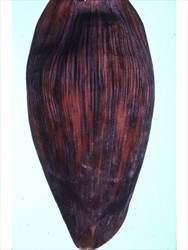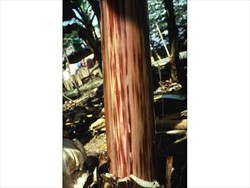Banana bract mosaic.
Pacific Pests, Pathogens, Weeds & Pesticides - Online edition
Pacific Pests, Pathogens, Weeds & Pesticides
Banana bract mosaic (552)
Banana bract mosaic virus. The abbreviation is BBrMV. It is a flexuous rod virus. BBrMV is a member of the Potyviridae family. The virus disease was first detected in the Philippines in 1979.
Asia (India, Sri Lanka, Philippines, Thailand, Vietnam), North America (Hawaii) and South America (Ecuador), Oceania. It is recorded from Samoa, but its occurrence has been questioned.
Banana species, Musa acuminata, hybrids between Musa acuninata x Musa bulbisiana, and Musa textilis - are the main hosts. Other minor hosts reported are red ginger (Alpinia species) and cardamom (Elettaria species).
Plants may be stunted with fewer suckers, which may show distortions. Fingers remain small and unfilled. Characteristic symptoms are reddish-brown streaks on the bracts, the leaf-like structures covering the male flowers, or 'bell' (Photo 1). Green, spindle-shaped streaks may occur on the leaves (Photo 2), reddish streaks on the leaf stalks, and dark spindle-shaped streaks on the base of the stem when outer leaves are peeled away (Photo 3). Suckers used for propagation do not bear fruit.
Spread is by aphids in a 'non-persistent' way. The virus is picked up on the aphid mouth parts when feeding, transmitted when next feeding, and then the ability to transmit is quickly lost. Four aphid species have been reported to transmit BBrMV: melon aphid, Aphis gossypii; corn aphid, Rhopaloshiphum maidis; banana aphid, Pentalonia nigronervos; and cowpea aphid, Aphis craccivora - (see fact sheets nos. 38, 330, 103, and 356). Long distance spread is associated with the transfer of infected suckers for planting. It can also occur in tissue cultured plants if not checked for virus infections.
BBrMV is spread rapidly by aphids and can cause substantial economic damage. For example, in the Philippines, yield losses of up to 40% are reported in Cardaba and Saba varieties. Bunches are distorted and the fingers are underdeveloped. In general, plantains (AAB/ABB) show greater damage from BBrMV infection compared to other banana groups. However, commercial Cavendish subgroups (AAA) are susceptible as seen from BBrMV epidemics in southern Philippines. Similar losses in a range of subgroups have been reported from India.
Look for stunted plants with fewer, possibly distorted, suckers, spindle-shaped streaks on leaves, leaf stalks, and stems when old leaves removed.
Tests based (i) on serology (isolates from India, Philippines, Sri Lanka), and (ii) on the coat protein gene (isolates from Philippines, India, Samoa, Vietnam), showed the isolates were closely related. However, further investigations have been suggested because in India, Thailand, Vietnam and Samoa, atypical symptoms occur. The presence of Cucumber mosaic virus (see Fact Sheet no. 100) and Banana streak virus (see Fact Sheet no. 215) may be a complicating factor. For example, in Samoa plants with BBrMV were co-infected with a small bacilliform virus, and showed symptoms characteristic of Banana streak virus.
The presence of BBrMV was reported from Samoa in 1999, based on antibody (western blot) and PCR tests, but two subsequent surveys failed to confirm symptoms of the disease, although only a small number of plants was tested.
BIOSECURITY
The risk of introduction is high due to BBrMV limited distribution and ability to spread rapidly, and the consequences from introduction could be severe. Banana plants should only be transferred between countries as tissue cultures tested to ensure that they are free of all known banana diseases. Plants of many varieties of bananas, tested to internationally agreed standards, can be obtained from the INIBAP transit centre in Belgium, and from IITA, Nigeria. The FAO/IBPGR Technical Guidelines for the Safe Movement of Germplasm. No. 15. Musa. 2nd Edition, gives details of the methods to use (http://www.bioversityinternational.org/uploads/tx_news/Musa_spp.__2nd_edition__502.pdf).
Notify agriculture authorities if symptoms of BBrMV are seen.
CULTURAL CONTROL
Key actions in managing BBrMV are: (i) only plant suckers from a known source where no plants with BBrMV symptoms have been seen or, if establishing or replanting a commercial plantation, use virus-tested tissue cultures; (ii) rapidly remove diseased plants (see below) and (iii) restrict people entering plantations to those working on the crop, to reduce chances of introducing BBrMV-infected aphids.
Before destroying plants with BBrMV symptoms, spray the diseased plants with soap, oils, kerosene or insecticide to kill aphids (see below).
After killing the aphids, there are three choices:
- Method 1: Within 48 hours, dig out the stool, including the main plant and all suckers. Chop the plant, including the corms, into small pieces. Burn or bury.
- Method 2: Inject the diseased plant with herbicide (e.g., glyphosate, 1 part to 5 parts water). Inspect the plant to make sure it is dead. If not, retreat.
- Method 3: Scoop out the middle of the stem and pour kerosene into the well. Inspect the plant to make sure it is dead. If not, retreat.
RESISTANT VARIETIES
No resistance to BBrMV reported; however, host range is not fully known.
CHEMICAL CONTROL
Use chemicals to kill aphids on diseased plants only. However, it is not a method guaranteed to prevent aphids from transmitting BBrMV. Aphid transmission is rapid, and an infected aphid can feed and spread the virus before it has come into contact with the insecticide and been killed by it.
The choice of chemicals for killing aphids on diseased plants, before removal, depends on whether they are grown for household use or for sale.
- Banana grown for home use: Use soap solution, white oil (vegetable oil) or horticultural oil (petroleum oil) (see Fact Sheet no. 56). Kerosene can also be used as mentioned above. Aim to spray the 'throat', the V-shaped area where the leaves meet and where aphids hide.
- Bananas grown commercially: use synthetic pyrethroids.
Note, the following have been recommended previously in Pacific island countries: dimethoate (400 g/L), used at 75 ml/100L; diazinon (200 g/L), used at 1.5 ml/L; acephate (75% WP), used at 1.3 g/L. BUT, in Australia, the use of dimethoate and diazinon are under review by the APVMA.
____________
When using a pesticide, always wear protective clothing and follow the instructions on the product label, such as dosage, timing of application, and pre-harvest interval. Recommendations will vary with the crop and system of cultivation. Expert advice on the most appropriate pesticides to use should always be sought from local agricultural authorities.
AUTHOR Grahame Jackson
Information from Thomas JE et al. (1997) Purification, properties, and diagnosis of banana bract mosaic potyvirus and its distinction from abaca mosaic potyvirus. Phytopathology 87: 698-705; and Rodoni BC, et al. (1999) Characterization and expression of the coat protein-coding region of banana bract mosaic potyvirus, development of diagnostic assays and detection of the virus in banana plants from five countries in southeast Asia. Archives of Virology 144: 1725-1737; and Geering ADW (2010) Banana bract mosaic bract virus. Museum of Victoria. PaDIL - (http://www.padil.gov.au); and Plant Biosecurity and Product Integrity (2018) Banana bract mosaic virus. Department of Primary Industries, NSW, Australia; and CABI (2021) Banana bract mosaic virus (banana bract disease). Crop Protection Compendium. (https://www.cabidigitallibrary.org/doi/10.1079/cabicompendium.8160); and from Davis RI, Ruabete TK (2010) Records of plant pathogenic virus and virus-like agents from 22 Pacific island countries and territories: a review and an update. Australian Plant Pathology 39(3): 265-291. Photos 2&3 John Thomas, QAAFI, University of Queensland, Australia. Photo 3 Lawrence Kenyon (ex. NRI, Chatham, Kent, UK).
Produced with support from the Australian Centre for International Agricultural Research under project HORT/2016/185: Responding to emerging pest and disease threats to horticulture in the Pacific islands, implemented by the University of Queensland and the Secretariat of the Pacific.






